Flower Designing with Rhododendrons
Amy R. Brandon
Port Townsend, Washington
Rhododendrons bring beauty to our gardens and enhance the artistic design of our landscaping. But why limit them to our gardens? Try using trusses in a flower arrangement to brighten and bring pleasure to your indoor living.
Basic Design Concepts
ELEMENTS
Flower designing is an art form using plant material as the medium. Anyone can learn to arrange rhododendrons, or other flowers, by following these suggestions. In creating a flower design, basic design elements are used. They are line, form, color, texture, pattern, size, light and space. These elements are combined to make any design whether of flowers, fabrics or paintings.
Line
is a visual path, enabling the eye to travel easily through the design. For line use branches, vines, weathered wood, etc. Line can establish the structural framework of a design, and it also will establish rhythm throughout the design.
Form
is three-dimensional. Forms can be closed or open or have see-through parts. Forms are the flowers or leaves or even the whole design.
Color
refers to the visual sensations responding to the wavelength of light reflecting from the plant surfaces.
Texture
refers to the surface quality of materials that respond to sight, touch and/or mind.
Pattern
is the design formed by the solids and spaces. The plant material, the container, and other components form the pattern of the completed design.
Size
is concerned with the visual size, not the actual dimensions.
Light
is the illumination necessary for vision. Light may also be used as a part of the design by using a flashlight or other light source. These sources are not to be seen, but only to light certain parts of the design for special effects.
Space
is the open area around the design and also within the design. The placement of the lines and forms determine the sizes and shapes of the spaces.
PRINCIPLES
Elements are the basic structures of designs. To use these elements, the principles of design have been developed. These principles are Balance, Proportion, Scale, Rhythm, Dominance, and Contrast.
Balance
is visual stability and can either be symmetrical or asymmetrical, but asymmetrical is much more interesting. One needs to be aware of forward and backward balance as well as side to side. Depth can be achieved by finishing the back of the design as well as by overlapping forms. Denser, bolder forms as well as larger sizes, darker colors and coarser textures are kept low in the design forming a focal area and giving stability. Balance may sometimes be achieved by the way the design is placed against its background, thus using space as an integral part of the design.
Proportion
is the relationship of areas and amounts, for example: the amount of plant material to the size of the container, the height to the width of the design, or the design to the background. The container should fill about ⅓ of the space used and the plant material 2⅔ of the space occupied by the design. The background space should be filled ⅓ to ⅔ by the total flower design for good proportion. The background space refers to the wall area where you are placing the design or to the tabletop on which you are placing the design. In other words, it should look as though it fits.
Scale
is the size relationship of one object to another, for example: the size of the individual blooms to the container and also the size of any accessory used compared to the container. An individual bloom should appear to be no larger than ⅓ the size of the container. Any accessory used should appear to be in keeping with the other materials - not appear gigantic or diminutive and not detract from the design itself.
Rhythm
is the dominant visual path through the design achieved by line or by the use of repetition or gradation of flowers in a linear direction throughout the design. Prune out surplus leaves and even flowers for clarity of line.
Dominance
is the greater force of one kind of element, for example: more of one kind of line, more of one kind of form, more of one color, etc. Dominance provides unity or harmony.
Contrast
means difference and that can be in size, form, color, etc. Contrast stimulates interest.
These design elements and principles of designs have been developed and used by the National Garden Clubs, Inc. and can be found greatly enhanced in their "Handbook for Flower Shows."
Designing with Rhododendrons
Two very different theories of flower design have been developed, the European mass designs and the Japanese linear designs. These two met here in the United States where they have been combined into massed line designs which appeal to Americans.
A BASIC DESIGN
To make a rhododendron design, select and harden off the plant material. To do this, cut the material several hours or even the night before arranging. Cut the stem ends of woody material length-wise - an inch or so several times to allow for better absorption of water; place into a pail of warm water. Soft plant material should be placed in cool water. Store the pails in a cool dark place until ready to arrange.
Select a container; a low bowl is a good choice to start. The bowl should be of a muted color with little or no ornamentation. The plant material, not the bowl, should be dominant. Place a needle holder in the bowl. The needle holder should be heavy and from medium to fairly large size. For the first design, think of an exclamation point - a tall line with a low mass (Fig. 1). The line can be a leaf such as a crocosmia or iris leaf, or it can be an interesting piece of any tree branch, or even some weathered wood. To determine the height needed, take the measure of the container, its diameter plus its height. Multiply this measure by 1 to 3. This will be the height of the longest line. If it is heavy, 1 times, if the line is thin, 3 times the measure should be its height. For the first design try 2 times the measure. Determining the height of the design by this measurement is good for any arrangement.
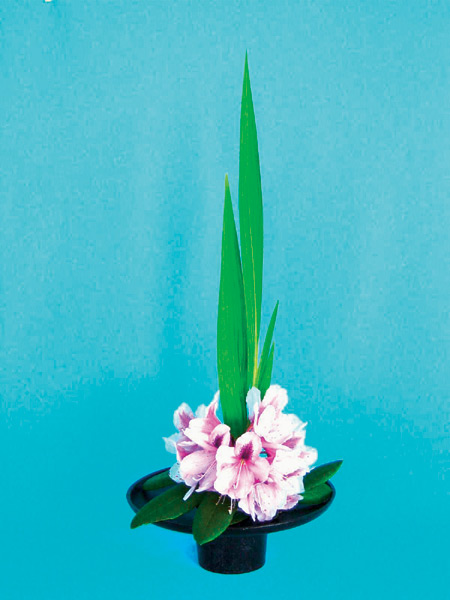
|
|
Figure 1. Exclamation Point Design. Low container with
a needle holder. Crocosmia leaves. Rhododendron 'Mrs G.W. Leak' with extra rhododendron leaves. Photo by Stephen R. Ricketts |
Place the measured line material in the needle holder with the tip of the line over its base. Then select a rhododendron truss with enough stem to place it in front of the vertical branch, keeping it low in the design, but above the lip of the container. It should appear to be coming out to greet you. This is the center of interest. It attracts your eye and is low enough to make the design appear stable and balanced. Select some foliage of any kind; peony leaves work especially well. Place a stem of them with the rhododendron truss so that some leaves show around the top and at least one side of the bloom. Use another stem of leaves to partially hang over the lip of the container. This ties the container to the design and ties the line material to the flower truss.
This exclamation point design can be enhanced by adding a second, smaller leaf with the first if that is what is used as the line, or a more intricate piece of branch material can be used. Notice then that interesting spaces have been created, that the design is balanced and rhythm introduced from the center of interest along the line to its tip.
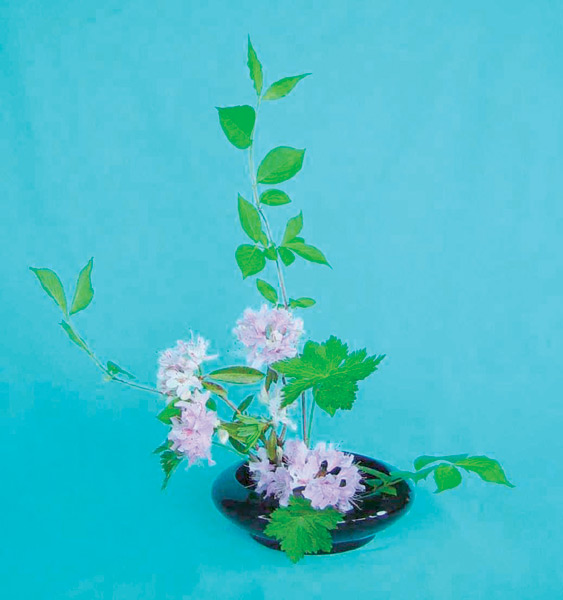
|
|
Figure 2. In the Manner of Japanese Moribana.
Low bowl with a needle holder. Stems and leaves of Weigela. Rhododendron yunnanense with geranium leaves. Photo by Stephen R. Ricketts |
IKEBANA INFLUENCES
The Japanese Ikebana designs suggest the next step in designing with flowers. The Moribana design uses three lines and three flowers (Fig. 2). Using odd numbers usually makes designs more interesting; however, advanced arrangers are experimenting with even numbers in their modern designs. When using the three lines, the longest one (A) is again 1 to 3 times the measure of the container. The second line (B) is ⅔ the length of A, and the third line (C) is ⅔ the length of B. Cut three rhododendron trusses (smaller trusses are easier to work with). These are to be cut to half the length of each branch.
Place the needle holder to the left side of the bowl.
The A branch is placed at the center back of the needle holder and leans slightly from the vertical position toward the left side and also slightly to the front.
The B branch is placed midway on the left edge of the needle holder and leans to the left almost halfway down and also comes almost halfway toward the front.
The C branch is placed in the right front corner of the needle holder and leans low to the right, almost to the tabletop and also comes forward. If this branch seems too long, crop it a little at the base. The A truss (use the stem with the smallest truss here) will go with the A branch and stand right up against it. The B truss will lean to the left along with the B branch, but not as low as the branch. The C truss, which is the largest of the three, will be placed at the front center of the needle holder, and will be placed low to anchor the design. The trusses are placed to all look at each other.
Cut stalks of leaves of any kind to enhance each grouping. Prune out excess foliage to keep the design simple and to ensure that no leaves are below the water level. The center truss will need leaves to fall over the lip of the container to tie the container to the design. The completed design is not crowded, has interesting spaces (an important concept in today's designs), is balanced, has rhythm and shows off the beautiful rhododendron trusses.
Variations can be tried by interchanging the placements of the groupings, A and B, varying the degree of slant from the vertical to achieve balance, and also by making a mirror design of the one described. Another variation, which can be used for a sit down table, places the needle holder to the right side of the low bowl with the longest (A) line placed at the mid left side of the needle holder and curving low across the water and the left front corner of the bowl (Fig. 3). For the center of the table design the B line can be placed at the center back of the needle holder, going toward the right back corner of the bowl, but not as low as the A line. The C line is placed at the right front corner of the needle holder and comes to the right front and low, almost to the tabletop. Place the trusses to complement each line with the C truss placed low in front of the needle holder. The whole design is low and allows dinner conversation and clear views of other dinner guests and still provides beauty for your table.
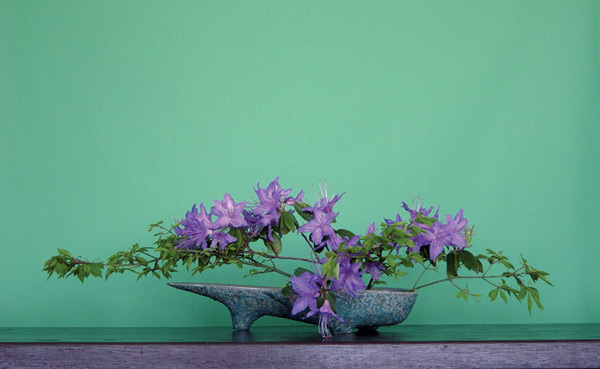
|
|
Figure 3. Sit-down Table Design. Low, oblong bowl with a needle holder.
Euonymus alatus branches and Rhododendron augustinii . Photo by Stephen R. Ricketts |
In all of these designs, the leaf material is placed as part of the design, but also hides the needle holder from view.
To try a more advanced design, the elements and principles of design are still used but with creativity added. Lines and spaces are particularly important in a creative design. For line material, dried branches, weathered wood, curving or twisted branches can often be found on the forest floor, the beach or even in one's own garden. Long leaves can be stroked into curving forms. Dried plant materials can be found in garden stores, or perhaps a garage sale, or dried from one's own garden. Another source of line material can be devised from manufactured forms such as embroidery hoops or discarded machinery parts, anything that looks interesting and can be cleaned and painted.
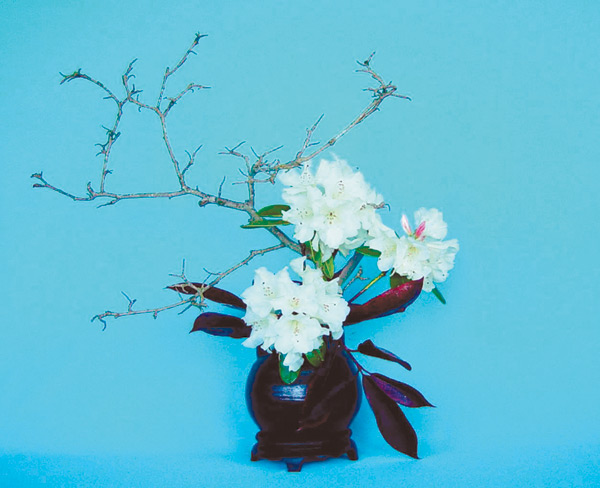
|
|
Figure 4. Weathered Branch Design. Dried branch of star magnolia. Bowl
and stand. New stem and leaf growth of Photinia . Rhododendron 'Unique'. Photo by Stephen R. Ricketts |
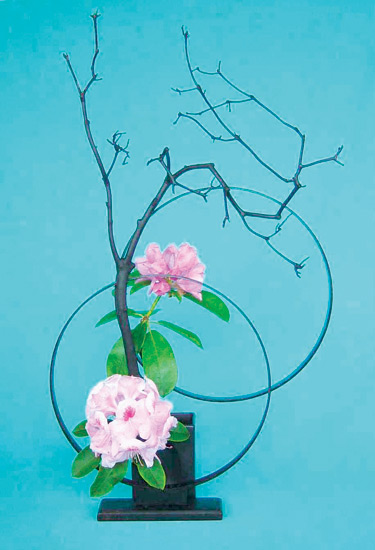
|
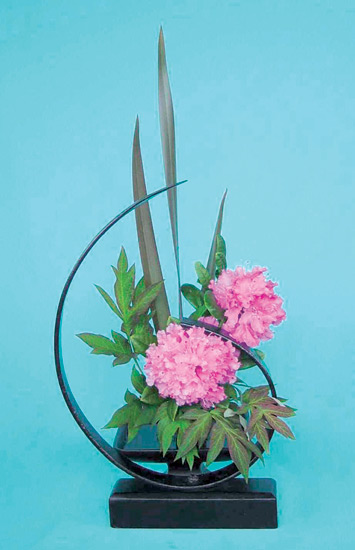
|
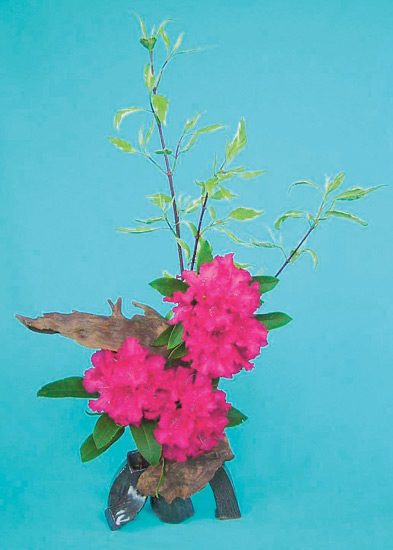
|
||
|
Figure 5. Embroidery Hoop Design. Bowl on a pedestal
with a needle holder. Embroidery hoops fastened together and painted black. Weathered wood painted black. Rhododendron 'Mrs Furnivall' Photo by Stephen R. Ricketts |
Figure 6. Scrap Iron Design. Black container with a
needle holder. Scrap iron is fastened to a wood base. New Zealand flax leaves and peony leaves. Rhododendron 'Jan Dekens'. Photo by Stephen R. Ricketts |
Figure 7. Piece of Weathered Wood Design. Weathered
wood has been worked and finished. Exotic container. Red stemmed dogwood. Rhododendron 'The Honourable Jean Marie de Montague'. Photo by Stephen R. Ricketts |
Arranging these materials in a container so that interesting spaces are formed is the challenge. Instead of arranging flowers, the object is to arrange spaces, not forgetting to keep it simple. When the lines are doing something exciting, a few rhododendron trusses can be added. One is placed for the center of interest. One or two others can be used to accent the rhythm that has been created, but care must be taken to leave most of the spaces vacant This creative design will showcase the rhododendrons as no mass design could.
Here is a checklist for creating your rhododendron design:
Measure the container to determine the proper height for the design.
Create a center of interest, with plant material cutting the lip of the container.
The container should be ⅓ of the visual surface, plant material at least ⅔ of the visual surface.
Cut lines and trusses at different heights.
Use plant materials in odd numbers.
Keep it simple. If it is not needed, don't use it.
Leave interesting spaces - both surrounding and within the design.
For added experience, enter a flower show. To a flower show, the design section is the icing on the cake. And so it is with our rhododendron shows. Nearly every flower society includes designs in their shows and viewers crowd around to enjoy them as well as the specimens. The purpose of a flower design is to show off one's horticultural ability by displaying the garden's results as well as to satisfy one's artistic talents.
Follow these basic elements and principles as you design with rhododendrons. The results will be pleasing and you will have discovered a new fun hobby.
Amy Brandon is an accredited Master Flower Show Judge who has entered many rhododendron shows in both design and horticulture. She has also run the design section for the Olympic Peninsula Chapter.